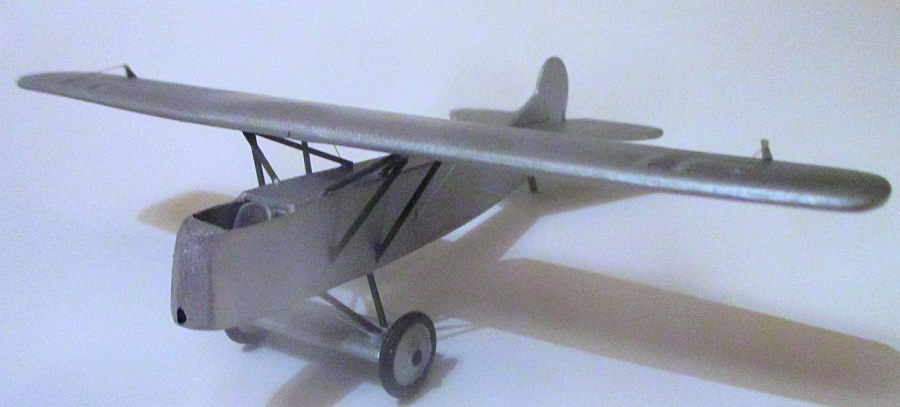
| KIT #: | 003 |
| PRICE: | $16.00 'used' |
| DECALS: | One option |
| REVIEWER: | Brian Baker |
| NOTES: | Very basic kit, suitable for experienced modelers only. |

| HISTORY |
The Fokker D.VII (E.V) was intended to be the successor to the highly successful D.VII series, and the first prototype, designated V.26-1, was a parasol high wing monoplane powered by a 110 hp. LeRhone rotary engine. After intense development, the fighter was put into production, placed in service, and after a series of wing failures, was withdrawn for redesign. Later production models, redesignated D.VIII, were placed in production, and were successful in the last months of 1918, although they had no real effect on the outcome of the war, which was already lost.
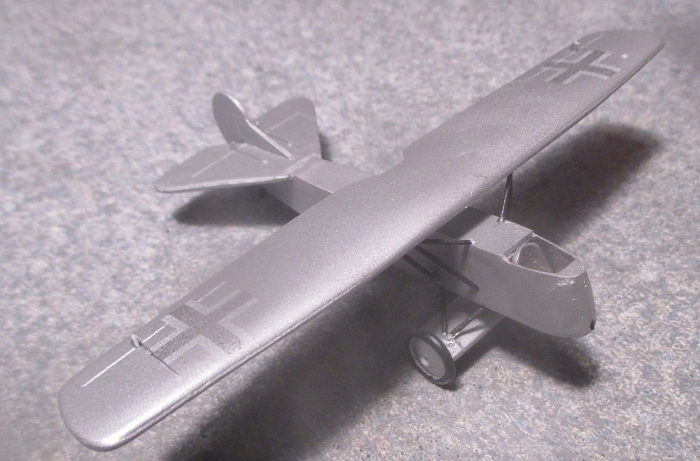 There are
numerous accounts of the career of this fighter, and one version refers to a
highly modified D.VII intended as a flying bomb. The engine was removed, a
warhead replaced it in the nose, and the idea was to tow the pilotless aircraft
to the target area, release it, and the pilot of the towplane would then guide
the glide bomb to the target, presumably by radio, although the exact method of
control has not been revealed. Not much is known of this project, and it
certainly did not result in a production aircraft.
There are
numerous accounts of the career of this fighter, and one version refers to a
highly modified D.VII intended as a flying bomb. The engine was removed, a
warhead replaced it in the nose, and the idea was to tow the pilotless aircraft
to the target area, release it, and the pilot of the towplane would then guide
the glide bomb to the target, presumably by radio, although the exact method of
control has not been revealed. Not much is known of this project, and it
certainly did not result in a production aircraft.
Following the end of World War I, the Germans were required by the Treaty of Versailles to turn over all military aircraft to the Allies, especially all Fokker D.VII fighters. Fokker, being of Dutch citizenship, was able to move trainloads of his assets from Germany into the Netherlands, among these being examples of the D.VII and D.VIII fighters. Again, exact details of these shipments, which were probably aided by bribery of various officials, remain unclear. Fokker continued the development of various aircraft types, and expanded his operations to produce some very excellent aircraft in England, the United States, and several other countries. The V.30 appeared after the war, and was displayed at the Paris Air Salon in 1921 as a towed single place sport glider, from which several photographs survive. One issue was the fact that on the displayed aircraft, the paint job just barely covered up the German crosses on the wings, angering some of the French visitors to the display. So much for using a Fokker D.VIII wing.
| THE KIT |
The kit
consists of basic components, including fuselage, seat, pilot, wing, struts,
engine and prop, tailplane, and landing gear. Most of these are roughly molded,
and need some trimming. I found that on the D-VIII model, I could detail the
cockpit interior fairly easily, and the results were effective. I replaced the
struts with plastic strip, with questionable results. On the V.30 model, I
replaced all of the struts with very thin plastic rod, replacing the fuselage
with a scratchbuilt unit, and using all of the other basic airframe parts. The
fuselage was built up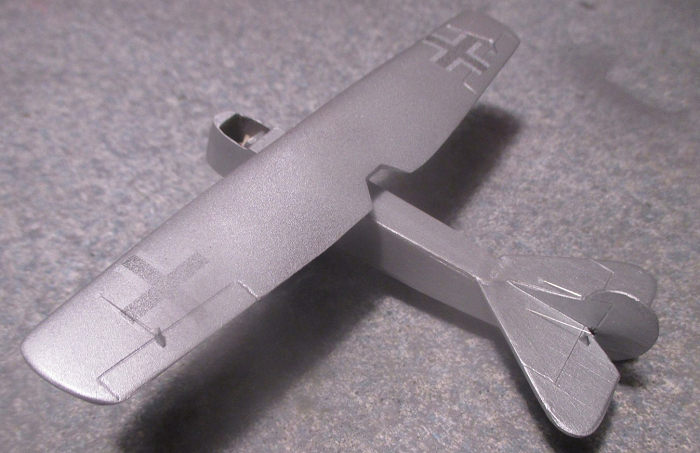 from card plastic, and proved to be quite a robust structure once finished. The
nose section, containing the cockpit, took some doing, but I finally got it
right.
from card plastic, and proved to be quite a robust structure once finished. The
nose section, containing the cockpit, took some doing, but I finally got it
right.
All in all, the quality of this kit is marginal, and it takes a lot of work to get it up to acceptable standards. However, it is all I had to work with, so now I have two models of the aircraft, one a fighter and one a glider.
The kit instructions consist of two 8 ½” x 11” sheets of mimeographed paper. Page 1 gives a short history of the aircraft, and a list of references that would be useful in building a model of the D.VIII. Assembly instructions are basically a series of commands, cut this, glue this, etc. There is extensive color scheme information, but it is basically “where can you go to find information on the aircraft”. I first built this model in 2000 (It is listed as first appearing in 1978) and I can see that I replaced some of the minor components, including the wing and landing gear struts. Looking at the ones I had for this model, I can see why.
Page 2 consists of a simplistic three view drawing of the D.VIII in 1/72 scale. It is not particularly well detailed, and some of the above mentioned sources have much better drawings. The instructions are not particularly useful, and an experienced modeler will use his or her experience in the assembly process.
| CONSTRUCTION |
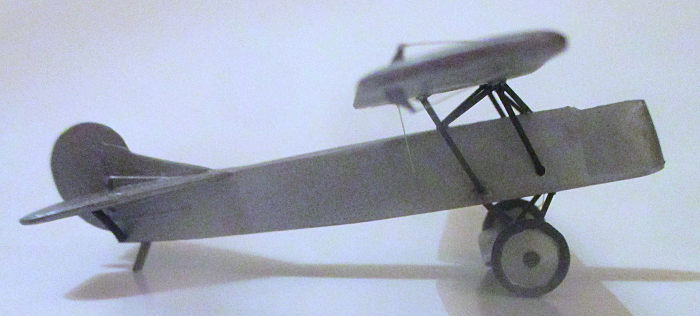 The
kit goes together rather easily once the parts are trimmed, and replacing the
struts is not that big a job. Lining up the wings and tailplane comes rather
easily, but it is more of a problem with the glider version, as the location of
the wing seems to change slightly from the fighter version. I drew a three view
in 1/72 scale, and found this useful in the process. On the V.30 model, I
painted the model before basic assembly, using the photos of the plane in Paris
as a guide.
The
kit goes together rather easily once the parts are trimmed, and replacing the
struts is not that big a job. Lining up the wings and tailplane comes rather
easily, but it is more of a problem with the glider version, as the location of
the wing seems to change slightly from the fighter version. I drew a three view
in 1/72 scale, and found this useful in the process. On the V.30 model, I
painted the model before basic assembly, using the photos of the plane in Paris
as a guide.
| COLORS & MARKINGS |
Colors and marking for the fighter version are typical of German Air Service aircraft of that era. For the V.30, there is no definite information available. I went on line, and found some discussion on the subject. One modeler said to paint the airplane silver and the struts black, which is what I did. Another questioned the use of silver, although looking at the two existing photos, I think silver is probably the most likely color, especially since a few of Fokker’s postwar C.II biplanes were silver overall. In any event, it looks like the plane in the pictures, and that is the point.
| CONCLUSIONS |
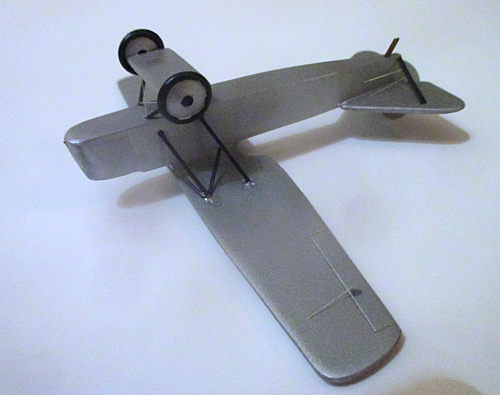 There is
no question that a Fokker D.VIII should be in any collection of German World War
I fighter aircraft, and this kit does provide that option. As for the V.30, this
fits into the postwar era, and I like the unusual types, and had been planning
to do this one for a long time. Now I’ve got one.
There is
no question that a Fokker D.VIII should be in any collection of German World War
I fighter aircraft, and this kit does provide that option. As for the V.30, this
fits into the postwar era, and I like the unusual types, and had been planning
to do this one for a long time. Now I’ve got one.
I think that if you want a V.30 conversion, there is now no reason not to do one. It is a lot of work, but builds up into a model that very few people have in their collections. If there are other Fokker D.VIII’s not available, perhaps you should consider those. I believe Roden and Eduard have also produced D.VIII kits, and these might work out better than the VeeDay kit. If not, this one will do the trick. Try it. Somewhat recommended.
| REFERENCES |
There are numerous reference works providing information on Fokker aircraft of the era. Henry Hegener’s Fokker, The Man and the Aircraft, has a lot of information on all Fokker aircraft. Peter Bowers’ paperback, Fokkers of World War One, has some useful information, as does Peter L. Gray and Ian R. Stair’s Fokker Fighters of World War I. Profile No. 67 on the Fokker fighters is also useful. There is no shortage of material on Fokker fighters, although it seems odd to me that with all of the interest in Fokker fighters in recent years, so few kits of the D.VII and D.VIII series have appeared.
16 February 2021
Copyright Modeling Madness.com. All rights reserved.
If you would like your product reviewed fairly and fairly quickly, please contact the editor or see other details in the Note to Contributors.
Back to the Main Page Back to the Review Index Page Back to the Previews Index Page